There are three main ways for the general public to get a foot into the crypto world: through trading, using DeFi services, or collecting NFTs. The initial trajectory of NFTs is similar to the crypto tokens, with buying and selling, aka flipping, being the main way to make money for NFT owners. But then, there was a piece of news making the rounds recently about a protocol called Drops that allows NFTs to be used as collateral for loans and earn interest. This sounds like the kind of news NFT owners have been waiting for - a chance to monetize their NFTs without selling them. Even though I'm not a NFT collector, I thought it would be interesting to check out the protocol to see how it works. Who knows? Maybe I might get inspired to be a collector if it is a solid one.
By the way, if you are unfamiliar with DeFi concepts, I highly suggest taking a quick detour and learning a bit more about it, especially when it comes to liquidity pools and LP tokens. This review will be peppered with DeFi terminology which I won't be able to go into too much detail. Ok, let's continue!
What is Drops.co?
On the outset, it advertises itself as a lending & borrowing platform for NFTs. Further investigation reveals that it's a lot more complicated than that. The pies it wants to stick its fingers in include:
- Being a launchpad for NFT projects
- Facilitate the buying and selling part
- Do NFT-drops for new projects with limited-edition NFTs
- Lending, borrowing, staking and yield-farming opportunities for NFT tokens
- "DeFi-style infrastructure to NFTs", according to its whitepaper.
The platform is built on the Polygon blockchain, one of the more popular Layer-2 scaling solutions for Ethereum to help users save on gas fees, making it a relatively painless experience for those heavy in NFTs transactions (minting, buying, selling, storing etc). It also utilises technology from Biconomy, a company that provides plug-and-play APIs for dApps to interact with the blockchain. Biconomy aims to provide mainstream users with a frictionless experience across multi-chains simply by connecting their wallet to any dApp and let the dApp take care of the gas fees, bridges etc under the hood. Looks like Drops is aiming quite high in their user experience.
Another note of interest is that this platform was developed in conjunction with a play-to-earn MMORPG NFT game called Node Runners Odyssey. The game allows players to earn real crypto tokens while they build a thriving economy in space. The native token, NDR, is also used as one of the accepted forms of governance tokens for the Drops protocol.
We'll go over the DeFi section of the website first since (half of) that part is already visible.
First Section: The DeFi Pie
The main page of the Drops website offers the ability for NFTs to participate in DeFi-like activities by using it as collateral to get a loan or earn interest. Those with DeFi tokens can also join in the fun. So far so good.
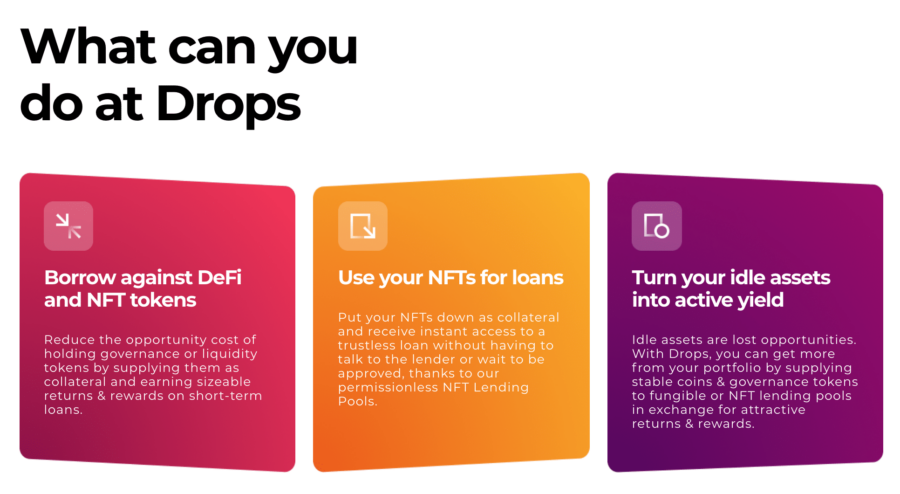
Scrolling down the page, I see a short explanation of how the NFT loans work.
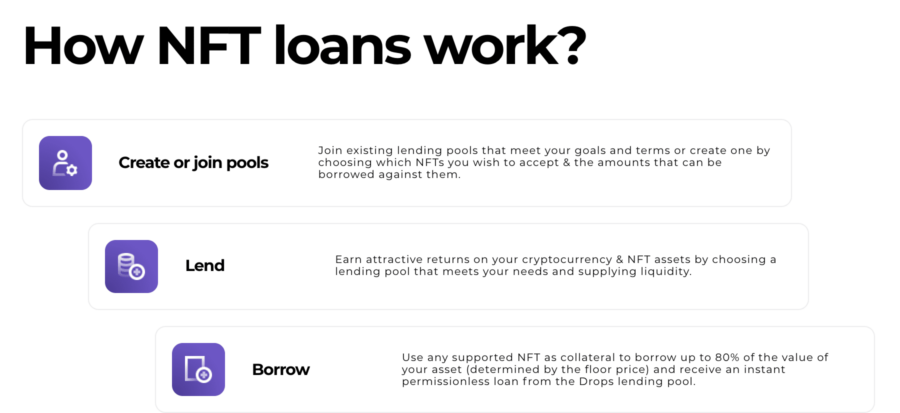
A cursory reading reveals that the mechanism is pretty much the same as DeFi lending & borrowing . The only thing missing is the actual meat-and-potatoes: which NFTs can be used? Any NFT or specific ones? How are the floor prices of NFT values gauged since that's the basis for the ability to borrow up to 80% of the asset's value?
The loans section of the website only has regular tokens available to loan and nothing on the NFT section. The likely place for the NFTs to be put into action is in the Stake section and that's not ready yet either.

The questions I had were partially answered in their whitepaper (not found on the website itself) where it gives more details about the mechanics of how things are conceived to work. Until this section is ready in the website, I can only go by what the whitepaper says.
How to yield-farm with NFT tokens
There are two ways outlined in the document: the vanilla way and the more complex way. Both are described in some level of detail. While reading through, some questions popped up in my mind.
The Vanilla way: Basic
Let's say you have 1 NFT token worth $100.
- Deposit the NFT token into a pool and mint 100 dNFT tokens in exchange. There is a 2% minting fee, so you're only getting 98 tokens back.
- At some point, you want your NFT back so you return the dNFT tokens to redeem it. There is also a 2% redemption fee, and here's where it becomes a bit tricky.
- Minting dNFT: 100 dNFTs - 2 (2% minting fee) dNFTs = 98 tokens.
- Redeeming NFT: 100 dNFTs borrowed + 2 (2% redemption fee) dNFTS = 102 tokens
- Difference of 4 dNFT tokens to be obtained elsewhere
I can only assume that there is a way for you to use the dNFT tokens you have to stake them somewhere else, either on this platform or some other platform's liquidity pool to earn them. The whitepaper doesn't elaborate further at this point. It's also unclear what the minting and redemption fees are used for, ie how much goes back to the protocol vs admin fee etc.
The scariest part about this method is the possibility that you might end up with another NFT that's not your own when it comes time to redeem it. This is implied in the next section. I'm not sure how this is going to work out because what're the chances of you getting something more valuable than what you deposited? Even if that were to happen, it means someone else got the short end of the straw. That can't be a good thing.

Ok, scary thought aside, let's continue to explore the other method.
Another Vanilla way: Lockup
Instead of depositing the NFT token into a pool, another way to obtain a loan is by locking up the NFT. Here's how it would work:
- Lock up the NFT that's worth USD100 in our previous example in a contract and pay a 2% minting fee. That's 100 dNFTs - 2 dNFTs = 98 dNFTs.
- This method also incurs a 0.2% premium fee for each day the NFT is locked up. This is paid in advance from 10% of the collateral borrowed against. Therefore, the math is: (100 dNFTs - 2dNFTs) - (100 dNFTs * 10%) = 98 - 10 = 88 dNFT tokens available for the depositer.
- When the balance of the 10 dNFTs reaches 0.2, the depositer has the option to extend the lock-up period by paying another 2 dNFTs. This would extend it for another 10 days.
Once again, there is no mention of how the fees would be used. Comparing both methods, the basic method seems to carry the biggest risk of losing your NFT in exchange for something else you wouldn't want. However, to retain the NFT, you'd have to pay a premium price for using it as collateral. Depending on the value of the NFT, some might think it's worth the price. The lesser of two evils is still evil.
Out of curiosity, I wonder what kinds of NFT types are accepted and found quite a few, sorted into three main categories:
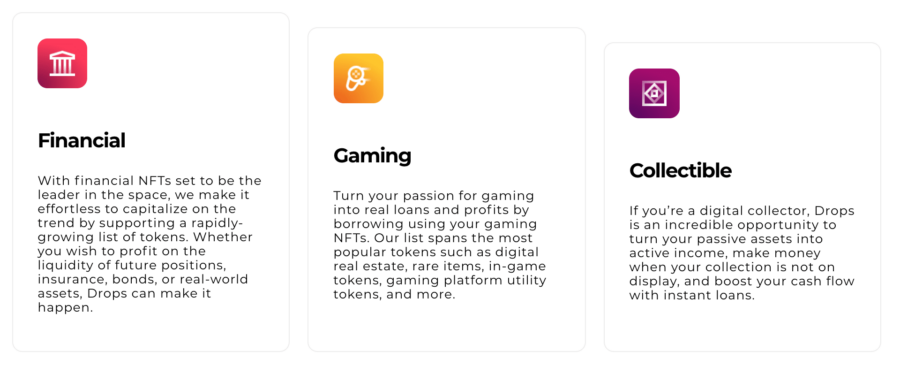
As if the two methods weren't exciting enough, the whitepaper details a third, more complex method, of making money from the NFT.
Margin NFT method
Starting out with that NFT worth $100,
- Deposit the NFT together with $100 worth of DAI into a pool. Let's call this the NFT/DAI pool.
- After passing the protocol checks, you get 200 LP tokens (100 dNFTs and 100 from the DAI).
- By doing the above, you have opened a Margin NFT position within the NFT/DAI pool. This costs you a daily fee of 0.05% (subject to change). This is covered by the amount of LP determined by you.
- You also get a Margin NFT Key that represents your claim on the position. This newly-minted token can be used for staking or to get a loan.
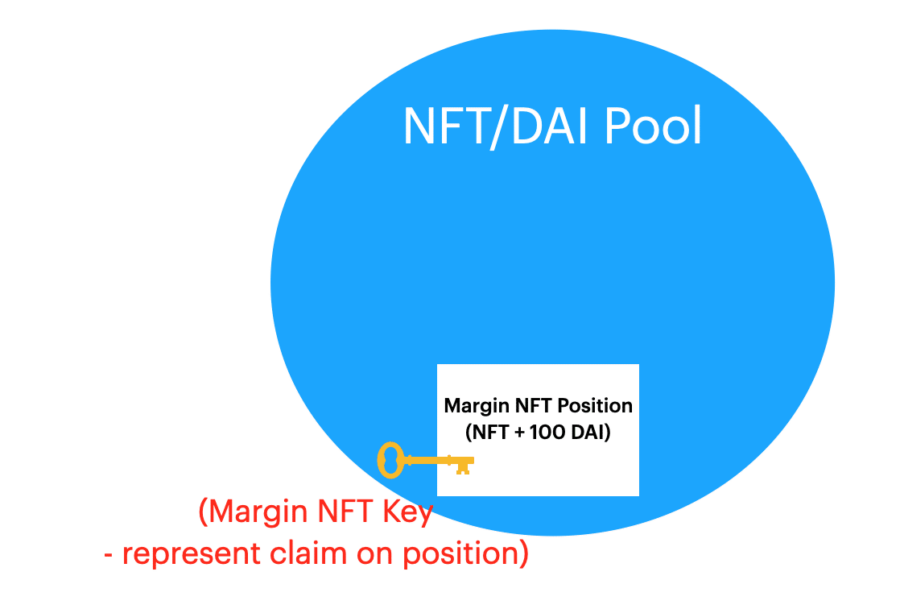
5. Some ways that the Margin NFT Key can be put to use:
- As collateral to get a loan on the Drops lending section. The collateral value will be based on the underlying dNFT tokens associated with the Key.
- For transference of ownership of the Margin NFT Position between two people.
- Staking it to earn DOP tokens and fees associated with the protocol.
6. To redeem the NFT asset and the DAI, return the NFT key to the protocol. The Key and the associated dNFTs will be burnt.
If you go over the amount allocated for the daily cost and did not top-up, the protocol will unlock your position, making the NFT available for liquidation. This means, anyone who supplies 200 dNFT tokens (double the initial minted amount) can buy your NFT from the protocol and the LP tokens.
There will be a maximum cap on how many dNFT tokens can be minted from a NFT. The actual figure is subject to community voting.
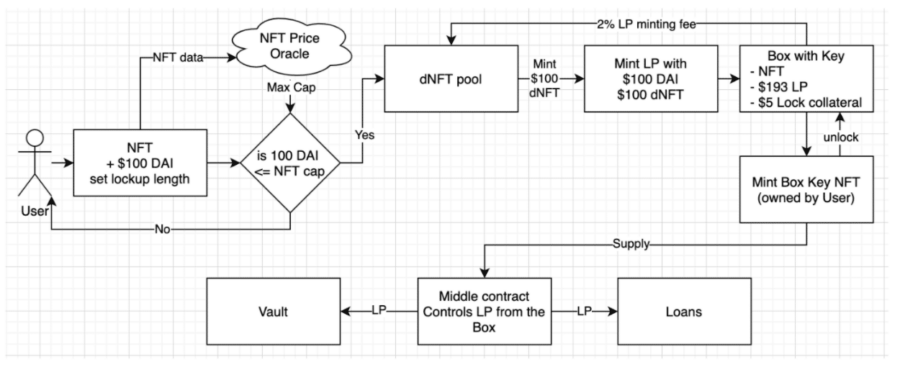
Loans on Drops
While it's all well and good that the diagram shows plans for the Margin NFT Key to be used in a loan, this is still vaporware at this point. What is actually on the platform are a bunch of tokens with a total supply of $7 million.
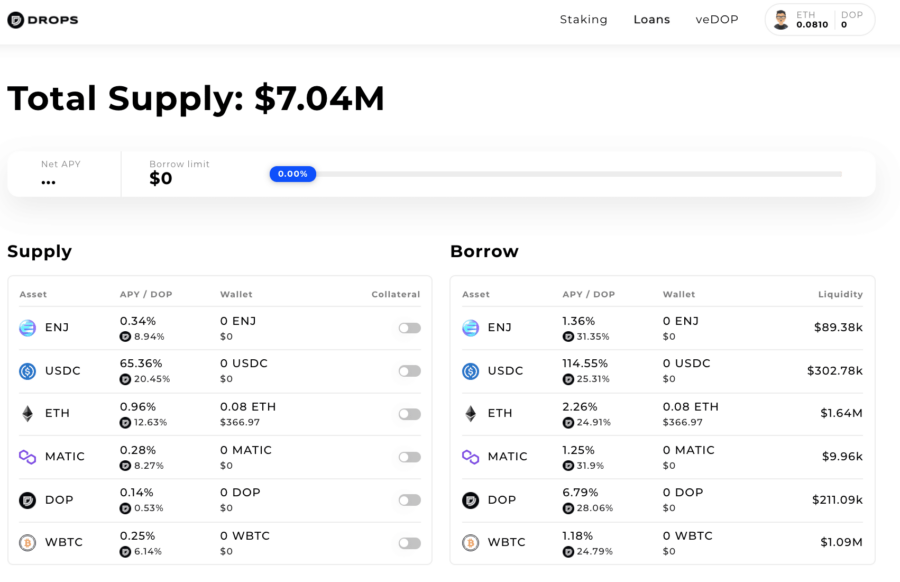
Most of the tokens on this list are known to me except DOP, aka Drops Ownership Power. It's the native token for the Drops protocol. Before delving further into DOP, let's continue with this section first. Using the ENJ token as an example, the interface for lending and borrowing is fairly straightforward except for the Distribution APY part. There is no mention of how this works anywhere I can find.
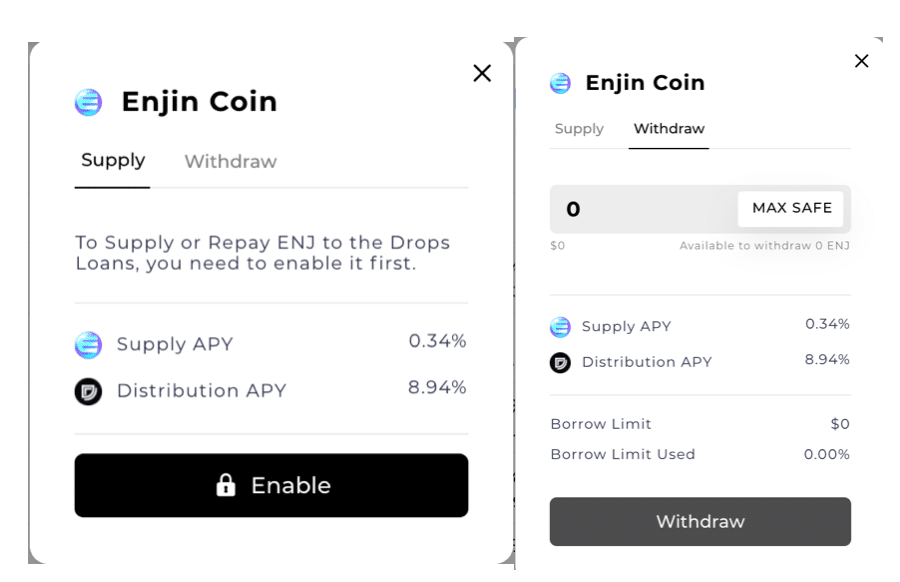
Their loan concept is based on Compound Finance's business model. If you choose to supply the Margin NFT Key to the protocol, it will be placed into a "middleman" contract. This action activates the transference of the LP tokens from the Position to the Loan section of the protocol or the Vault section, which will be covered further down.
Launchpad for NFT Projects
The Drops team seem to have some kind of a master plan for having the platform be a one-stop-shop for NFT-related activities. They are initially targeting the gaming NFTs, presumably because that's the space they are most familiar with from the experience they accumulated with the Node Runner game.
Based on the information I gleaned from various sources, I managed to deduce the following:
- The Drops team wants new NFT projects to be launched on their platform. These projects will be reviewed by the Drops team beforehand, check what kind of NFTs will be made available and rarity levels. The community gets to decide on the value of each NFT and what the rewards will be for holding it.
- The governance tokens of the NFT projects can be staked on the Drops platform to earn yield or used as collateral for loans.
- The team will organise NFT-drop styled events to encourage users to participate in the new NFT projects.
- These NFT projects will be mostly gaming-related ones, so the drops will be in-game items or rare merchandise.
- A variety of tokens can be used to purchase the tokens.
- Once the user obtains the NFT, it can be staked on the Drops platform in Vaults to earn dPoints. These points are:
- non-transferable tokens
- 1 dPoint = USD1
- Up to 90% of a NFT can be paid using dPoints. The rest will be a mixture of other tokens.
- Buying NFTs also gives users the opportunity to earn DOP tokens through a cashback scheme. How much of a cashback is given to users depends on the the amount of liquidity staked by the user.
Drops Ownership Power (DOP) Token
The DOP token has the following functions associated with it in the protocol:
- Buying and selling NFTs on the platform
- Governance token in combination with NDR and veDOP tokens
- Payment for yield-farming rewards
- Cashback rewards for NFT Drops purchases
- Stake DOP for either dPoints or veDOP tokens
The token's total supply is 15 million, with 3.2 million currently in circulation at the time of writing. The initial launch price of the token was $1.76 and it's gone up to more than $4 in three months. Not spectacular by crypto standards but not too bad either, given that it's only available on one (minor) exchange and a DOP/WETH liquidity pool in Uniswap.

Just in case you're wondering what's the difference between wETH and ETH, the former is the ERC-20 standard version of the ETH token. This is because when ETH was first created, the standard didn't exist yet. Since the standard was introduced, almost all tokens adopted it, so ETH created a wrapped version of itself, hence wETH.
Token allocation is as below:
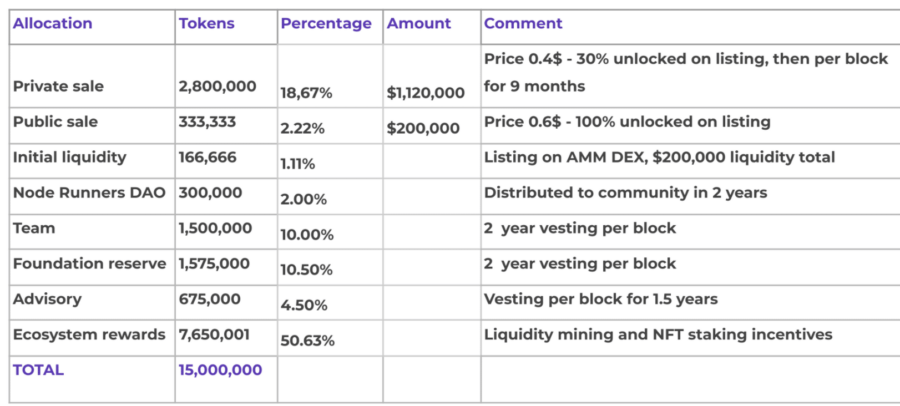
The governance function is designed to be in two parts: on-chain and off-chain.
On-chain Governance
For the on-chain part, the DOP token is used to govern Loans, including collateralization ratio, DOP emissions and the acceptance of new tokens as collateral. In addition, there is the option for users to lock in their DOP tokens to get veDOP tokens, that are used as a "vote-boosting" mechanism. This is a concept pioneered by Curve via their veCRV governance. Locking up DOP tokens for a long period generates more veDOP tokens.
veDOP tokens are used to collect fees from pools. They also represent a higher voting power than DOP tokens.
Off-chain Governance
This part of the governance uses a weighted system of voting that involves multiple tokens. The types of things that get decided include the usage of Drops treasury fund (where's the money coming from?), buybacks and distribution structure (of what?). The tokens involved are as follows:
- 1 vote for each DOP token in the wallet
- 3 votes for each veDOP token in the wallet (what about overlays?)
- 10 votes for each NDR token (why?)
Remember the Node Runner game and the NDR token mentioned early in the beginning of the article? Here's where it pops up, carrying quite a lot of weight on the Drops protocol. This is a red flag for me. The other point of concern is how the DOP/veDOP tokens work in voting. Since you can only get veDOP tokens from staking DOP, do you get double the voting power? Or the staked DOP tokens used to generate veDOP is out of play?
The People and Companies Behind Drops
Amongst the personnel listed on the Drops team page, three are of especial interest:
- Founder of Drops
- Also created Node Runner - created this first before Drops
- Has a Computer Engineering degree but subsequent jobs lean more towards marketing.
- Co-founder of Drops and Node Runners
- Used to work for Goldman Sachs
- Bachelor's degree in Banking, Finance and Management
- Lead blockchain developer/engineer
- Has a PhD in Computer Science
On a scale of 1 to 10, in terms of how solid the team is, I'm giving it a 4. Overall, the team doesn't have as much experience in blockchain projects as might be expected, except for the lead engineer, who has 6+ years of blockchain development experience. Their previous project, Node Runners, seems to be in a bit of a limbo. The website is down (as of time of writing) and the last meaningful interaction on their Reddit channel is more than 10 months ago.
After listening to Darius in an interview given earlier in the year, my skepticism did not abate. He did not sound as confident as I had hoped when answering questions from the interviewer, particularly when it came to the actual mechanics of how everything works.
The team managed to raise $1.1 million in a private round of investing from various blockchain ventures, some of which have spread their money around other big-name projects.
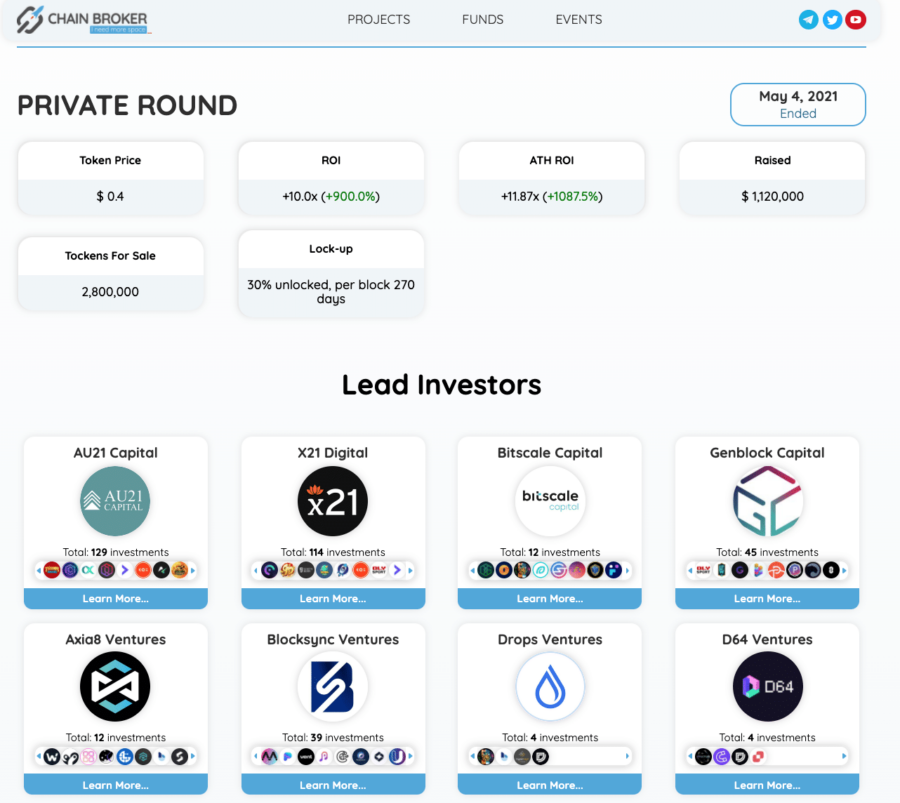
It's worth noting that most of the lead investors pictured above do not have Drops in their Selected Portfolio page of their website.
What the Future Looks Like
According to the roadmap in the whitepaper, they're now at the NFT Fractionalisation stage of development. Next would be enabling the Margin NFT, NFT staking and NFT loans scheduled for Q3 2021 delivery, and a NFT price oracle by Q4 2021. Seeing that we're already in November, they're definitely running behind schedule.
Their Twitter channel is actively seeking NFT Loan Testers for their testnet program. If you're interested to be one, click here to join. They are also active on Telegram and Discord.
Conclusion
This platform is all over the place in a major way, partly due to their ambitions. It's good that they have such a grand vision of helping to unlock liquidity to NFTs that are fairly illiquid itself. They have good ideas, but execution is key to the success of the project. What worries me:
- Where is the yield for staked NFTs coming from? Why would someone want to own a fraction of a NFT? What can you do with it? There are still unanswered questions floating around.
- Overcomplicating things with the introduction of so many kinds of tokens. The more complicated things are, the more likely that someone might figure out a way to game the system, which may expose flaws in the design, leading to the occurrence of unwanted situations.
- Squeezing a lot of functionality onto their native DOP token, especially what one can get from staking it. What are the pros and cons of getting veDOP versus dPoints?
- The messaging is confusing and there is no central source of information. What's in the whitepaper isn't in the Medium channel, and neither is in the website.
- A weighted system of voting with multiple tokens could easily lead to some kind of centralisation where people figure out which tokens to get carries the most weight, thus being able to vote in their own favour. It would help if there is a ceiling of how many votes someone can have regardless of the amount of tokens held.
- The Node Runner game seems to be down. Did it get abandoned to redirect the resources to build this platform? Or is it an indication that things could go pear-shaped in the future for Drops?
Those who have non-gaming NFTs will have to wait a lot longer as they work out the kinks of the project with the gaming NFTs first. Still, there are lots to look forward with what they plan to achieve. If they manage to pull the whole thing off, it would be a really impressive feat. I am taking a "wait-and-see" approach.
Disclaimer: These are the writer’s opinions and should not be considered investment advice. Readers should do their own research.


